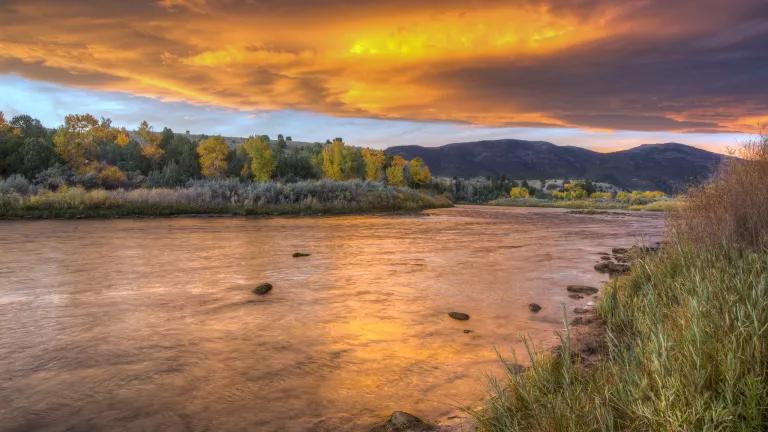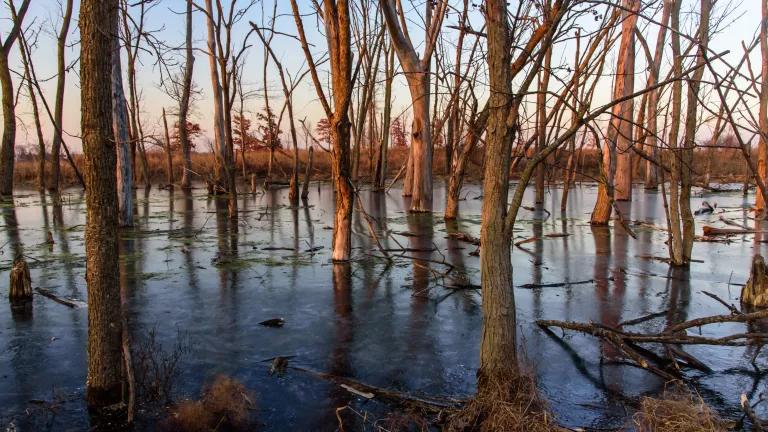Denial River: Court Orders Trial on Algae-Fouled Waterways, District Responds by Pretending They Don’t Exist

Illinois' algae-polluted waterways are finally going to get their day in court—twice now. Following on the heels of the recent Illinois appellate court decision in our favor sending the Metropolitan Water Reclamation District's water discharge permits back to the Pollution Control Board for further review, a federal court has now ordered that our citizen enforcement lawsuit against the District for excessive discharge of algae-fueling pollution will proceed to trial.
The District's weird public reaction to that outcome underscores the underlying problem: District officials would rather deny algae pollution than fix it. The District's press statement focused on a blog I had posted explaining the earlier Illinois appellate decision. That blog contained a picture (shown below) taken by Sierra Club scientist Dr. Cindy Skrukrud of an algae-choked stretch of the Lower Des Plaines River, which I had also included in a blog posted in 2014 when we filed the challenge. The District's press office, apparently with a bit too much time on its hands, located the photo in an obscure online publication that had appropriated it without our permission and mislabeled it as the "Lower Des Moines River." The press office sleuths then issued a statement accusing us of having appropriated and mislabeled the photo "because there are no pictures of the CAWS that display this problem."

This attempted gotcha kind of fell apart when the online journal profusely apologized to us, and promptly corrected the photo's attribution and location (note, also, that you can see all the industries on the east side of the Des Plaines River in the background). If you still wonder whether there are any "pictures that display the problem," have a look at the rest of Dr. Skrukrud's photos of the Lower Des Plaines River. The Lower Des Plaines is immediately downstream of the CAWS, meaning that the algae-fueling pollution in it comes from the District's plants. As to algae in the CAWS itself, though, the District knows quite well that there are plenty of photos that "display the problem" because those photos—such as those posted with this blog—were provided to the District in discovery in our case and used as exhibits in witness depositions.

These pictures, and the District's brazen denial of reality, are exactly the sort of thing that makes us glad we're finally going to trial. Our waterways deserve real evidence and a real remedy. That is what trial in our federal case can in principle provide for, now that we're past the District's efforts to make it go away.
The case is grounded in the District's violation of its permit condition prohibiting any wastewater discharge that causes or contributes to unnatural levels of algae and plant growth. The District responded to it with a motion asserting, in essence, that the algae pollution problem is being dealt with by government agencies, so the litigants and the public should just go home and wait for everything to get better. We, in turn, argued in a motion that our experts' reports pretty clearly show even without a trial that the District is violating its permits, which is all that should matter in an enforcement case.

The court rightly saw through the District's "let's just wait for the government to act" approach, and cut to the chase: the District has a permit limit, and it's the court's job to assess whether it's being complied with. On our motion, the court decided that with conflicting expert testimony in the mix, it will be necessary to sort out the facts at trial; but provided us with a road map of what our proof will look like.
Of course, trials can be costly and difficult. But that fact merely underscores the need for numeric limits on phosphorus and other algae-fueling "nutrient" pollution in water quality standards and permit limits, which we have been fighting for in other contexts—and which was the issue in our other recent victory. The Clean Water Act citizen suit provision, under which we sued the District, was designed to be simple and straightforward, based on the use of hard numbers in permits, which make it easy to show when there's been a violation. Here, in the absence of such hard numbers, the exercise necessarily involves more than just pointing to a permit limit number. But our experts are up to the task, and we will do whatever's necessary to fix the problem the District so adamantly insists on denying.




